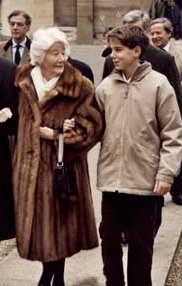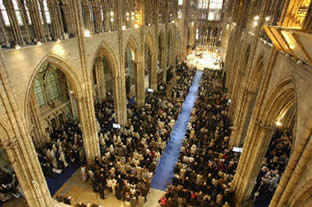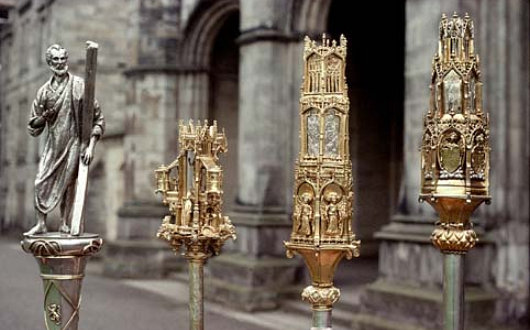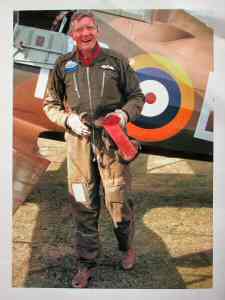2004 June
About Andrew Cusack
 Writer, web designer, etc.; born in New York; educated in Argentina, Scotland, and South Africa; now based in London.
Writer, web designer, etc.; born in New York; educated in Argentina, Scotland, and South Africa; now based in London. read more
News
Blogs
Reviews & Periodicals
Arts & Design
World
France
Mitteleuropa
Knickerbockers
Argentina
The Levant
Africa
Cape of Good Hope
Netherlands
Scandinavia
Québec
India
Muscovy
Germany
Academica
Louis XVII, requiescat in pace…
An interesting story for all my fellow traditionalists.
PARIS –  France laid to rest one of its most intriguing mysteries on Tuesday when it installed the tiny heart of Louis XVII – the son of beheaded king Louis XVI and queen Marie-Antoinette – in a royal crypt outside Paris.
France laid to rest one of its most intriguing mysteries on Tuesday when it installed the tiny heart of Louis XVII – the son of beheaded king Louis XVI and queen Marie-Antoinette – in a royal crypt outside Paris.
European aristocrats were among the 2,500 people who packed into the Saint-Denis Basilica north of Paris to watch the 209-year-old heart in its crystal vase given a final burial after spending a long period as a much-traded curiosity in the wake of the French Revolution.
A 12-year-old descendant of France’s former royal family, Amaury de Bourbon-Parme, handed over the heart in a formal Mass broadcast to another 1,000 people watching outside. The presiding priest, Archbishop Jean Honore, paid homage to the “lost child who knew nothing of what he was and of what he is”.
Louis-Charles,  the so-called “lost dauphin” who would have reigned as Louis XVII, died of tuberculosis at the age of 10 on June 8 1795 in a windowless cell in the French capital’s Temple Prison, where he had been incarcerated with his parents before they were guillotined.
the so-called “lost dauphin” who would have reigned as Louis XVII, died of tuberculosis at the age of 10 on June 8 1795 in a windowless cell in the French capital’s Temple Prison, where he had been incarcerated with his parents before they were guillotined.
“This is a way to give this child-martyr, who passed away in tragic circumstances and around whom mystery swirled for more than 200 years, a proper death,” said Charles-Emmanuel de Bourbon-Parme, one of Louis XVII’s relatives.
(Agence France Presse)
Into Honours!
I have just checked my results on the Student Portal and it turns out that I have passed every single course this term. “Big deal!” you cry? Well it is a big deal for we, the generally disinclined to work. Especially since I took one more course than usual each term this academic year to make up for the failures of my first year.
This means that I have passed my first two years of university and am now into honours. Thus, God willing, in two years time I shall be Andrew K.B. Cusack, M.A. (Hons) St Andrews.
I’d like to thank all my staff, most especially my secretary, Miss Alexandra Jennings, and my cook, Miss Jocelyn Archer, for selflessly contributing to the Cusack effort and ensuring that Candlemas Term 2004 was a resounding success.
Altar at Our Lady of Walsingham
 Check out the high altar in the brand new Church of Our Lady of Walsingham in Texas. The church was designed by HDB, formerly known as Cram and Ferguson. They are the firm responsible for the second plan for the Cathedral of St. John the Divine here in New York. (The design most completed of the three so far). A new stained glass window has since been installed behind it, and more glass is to come. Visit the Church’s website here.
Check out the high altar in the brand new Church of Our Lady of Walsingham in Texas. The church was designed by HDB, formerly known as Cram and Ferguson. They are the firm responsible for the second plan for the Cathedral of St. John the Divine here in New York. (The design most completed of the three so far). A new stained glass window has since been installed behind it, and more glass is to come. Visit the Church’s website here.
‘Diary of a Nomad’
Langston Fishburne is probably one of the most fascinating people I know. He always adds that extra bit of surrealism to an everyday situation to make it extraordinary. Among his many achievements, he is the only person to have pinched Sarah S.’s bottom on three different continents. A ballet dancer as well as a keen equestrian despite his ghastly horse allergy, Langston tells me that he has inherited my old Math textbook under the tutelage of the infamous Mr. Donald Johnson at TD.
I recall one day in the thoroughly uninspiring refectory of the aforementioned academy, Langston and I convinced Thomas Mills that Langston’s father was known around the world as the premier builder and designer of aquariums, rather than the award-winning thespian that he actually is. Tom seemed rather upset to find out Langston’s father is not, nor has ever been, an aquarium impresario.
Nevertheless, Mr. Fishburne fancies himself a writer, and we look forward to the day we shall be able to read his first novel Diary of a Nomad in print. Here follows a synopsis:
The University Maces

On my last day in St Andrews before summer break, Michelle Romero and I were lucky enough to finagle our way into a private showing of the University’s maces to the Kate Kennedy Club, organized by the Head Janitor & Bedellus, Jim Douglas, M.A. It was amazing. The metalwork on these maces (six in total) is so intricate and beautiful.
The late R.G. Cant said that if he had to put a value to the maces, Bishop Kennedy’s mace (made in 1461 in Paris) would be worth £10 million, and the mace of the Faculty of Arts would be £5 million, though in effect they are priceless. I have to admit it was nearly frightening to hold £10 million pounds in your hands.
It’s such a shame that the modern mace for the whole of the University (furtherst left in the photo) pales in comparison to the others, especially since it is the mace used at Chapel and thus the mace used most often. Mr. Douglas told us that the rod of the Rector’s mace (not pictured) is actually a broomstick painted black. Apparently, the Principal and Vice-Chancellor, Dr. Brian Lang, is going to have it replaced with a lengthened ebony rod.
Squadron Leader Angus McKinnon McVitie (RAF Rtd), Old Philomathian
Last Christmas, Robert Leggat received  a card that “made [him] sit up with a jolt”. “It was from Angus McVitie, who had been at St. Alban’s a little before my time,” Mr. Leggat recalls, but by pure coincidence was a member of a church he and his wife went to when they arrived in their current home. “He had recognized my OP tie, and from then onwards we met from time to time, and travelled to London to attend an OP reunion. (For the uneducation: and Old Philomathian is a former student of St Alban’s).
a card that “made [him] sit up with a jolt”. “It was from Angus McVitie, who had been at St. Alban’s a little before my time,” Mr. Leggat recalls, but by pure coincidence was a member of a church he and his wife went to when they arrived in their current home. “He had recognized my OP tie, and from then onwards we met from time to time, and travelled to London to attend an OP reunion. (For the uneducation: and Old Philomathian is a former student of St Alban’s).
“His card stated simply that his cancer has spread, and that he expected to be called Home in the next few weeks,” Mr. Leggat writes. “He added that he had ‘the privelege of an interesting and rewarding life and my Christian faith to sustain me.”
As predicted, a few weeks later, Mr. McVitie did die, and his eulogy was read by Jack Wardle, who was his cousin as well as being an Old Philomathian. Here is part of it, reproduced from Mr. Leggat’s website:
Although cousin Angus would loved to have flown, for different reasons, Concorde and the Lancaster, and he had clocked up 11000 flying hours on all sorts of aircrafts, his greatest delight was the award of an Honorary Fellowship of the Society of Experimental Test Pilots in 1994 when he was numbered, amongst others, with Group Capt. John Cunningham of Comet fame, Charles Lindberg, Air Commodore Sir Frank Whittle. He had previously, in 1988, received The Derry and Richards Memorial Medal, from the Guild of Air Pilots and Air Navigators, for test flying of outstanding value.
Although no prizes to guess his Scottish ancestry, it all began in The Forgotten Colony – Argentina. The English, Irish, Welsh and Scots had settled there in the 19th Century, making an incredible contribution without actually ruling the place! They formed their own communities..most of the Scots were farmers as were my ancestors, forming strong matriarchal societies marrying others who came over the horizon!. They celebrated St Andrew’s Day and Burns Night, had Gatherings of the Clans and Caledonian Balls, started their own Scots Church with itinerant ministers, schools and cemeteries. Practically everybody was related, or thought they were, however distant.
Eventually we ended up in St. Alban’s College, a public School. Angus was a Day Boy; I a boarder which meant invites to tea etc. and I well remember his bedroom, littered with The Meccanno Magazine and models of Aeroplanes all over the place as well as hanging from the ceiling. We were also members of a boy’s Bible Class called Crusaders, run by one of the masters, Charlie Cohen, which also meant free tea and plenty of wads!
That’s where it all began. He just wanted to fly and there was no action in Argentina. So in 1943, in mid war, he worked his passage on a banana boat to Britain and joined the Bristol Aeroplane Company at Filton, Bristol as a student apprentice. It was the nearest he could get to aeroplanes, but discovered he could learn to fly Tiger Moths at the University Air Squadron. That’s when we joined up again about 1947/8… Bristol, Filton and Crusader leaders, where he was highly regarded. One of the seniors, now well into his 80’s, remembers him as a “genial, gentle, giant”.
The next stop was Glasgow University, early 50’s perhaps, where we tried to do Aeronautical Engineering. He flew most of the time and we lived in a place called Duntocher, which has disappeared, under motorways and development. The bungalow belonged to a certain Donald McLeod, whc had been commissioned in The Black Watch during the war, and was in ministerial training. The problem was looking after the place and studying at the same time. We often recruited, had to recruit, the ladies from the College of Domestic Science to spend a Saturday with us doing the necessary cleaning and cooking.
By 1950 he had decided on a career in the RAF and gained his ‘wings’ in 1951 at Syerston, Nottinghamshire. Posted to Transport Command, he served in the Middle East, during the Mau Mau Emergency. He was ADC flying top brass about as well as in his own words ‘dropping Bronco’ from Valettas and Ansons. He managed to fit in a wedding to Sheila in 1957.
But all along, his boyhood ambitions was in test flying, as did so many in that era. In 1956 he was accepted for the Empire Test Pilots School at the Royal Aircraft Establishment at Farnborough — “the hardest years’ work I ever did” — and stayed on there for three years after qualifying, as the last test pilot with the National Turbine Establishment.
Then, all set to return to Transport Command Brittania Squadron at Lyneham, someone called him back and asked, rather apologetically, if he wouldn’t mind going instead to RAE Bedford as Commanding Officer of Aero Flight, which was, in those days a plum test pilot’s job. After two years, there was Staff College at Bracknell, followed by secondment to the Royal Malaysian Air Force running their Joint Operations Centre during the emergency. A desk job at the MOD, dealing mostly with fighter and helicopter cockpits was a pain…endless meetings fighting with financiers and so much being cancelled, with hardly any flying, decided him to take early retirement with the rank of Squadron Leader, and joined the College of Aeronautics at Cranfield Aerodrome as Chief Test Pilot in 1968.
But for all that, and its quite a career, Angus’s greatest joy was Sheila and Shuna, Fiona and Lorna… as he wrote in his Christmas card “the privilege of our interesting and rewarding life and my Christian faith to sustain me”. He had already written “my time to be with the Lord is fast approaching”. Well, that is where he is which is far better. He knew from an early age the assurance and certainty that his name was written in the “Lamb’s book of Life” (Rev 21.27).
Eternal rest grant unto him, O Lord, and let perpetual light shine upon him. May he rest in peace. Amen.
Search
Instagram: @andcusack
Click here for my Instagram photos.Most Recent Posts
- Letters Patent May 8, 2024
- Bicycle Rack April 29, 2024
- Burns Tower April 19, 2024
- Patrick in Parliament March 18, 2024
- Articles of Note: 13 March 2024 March 13, 2024
Most Recent Comments
Book Wishlist
Monthly Archives
Categories


